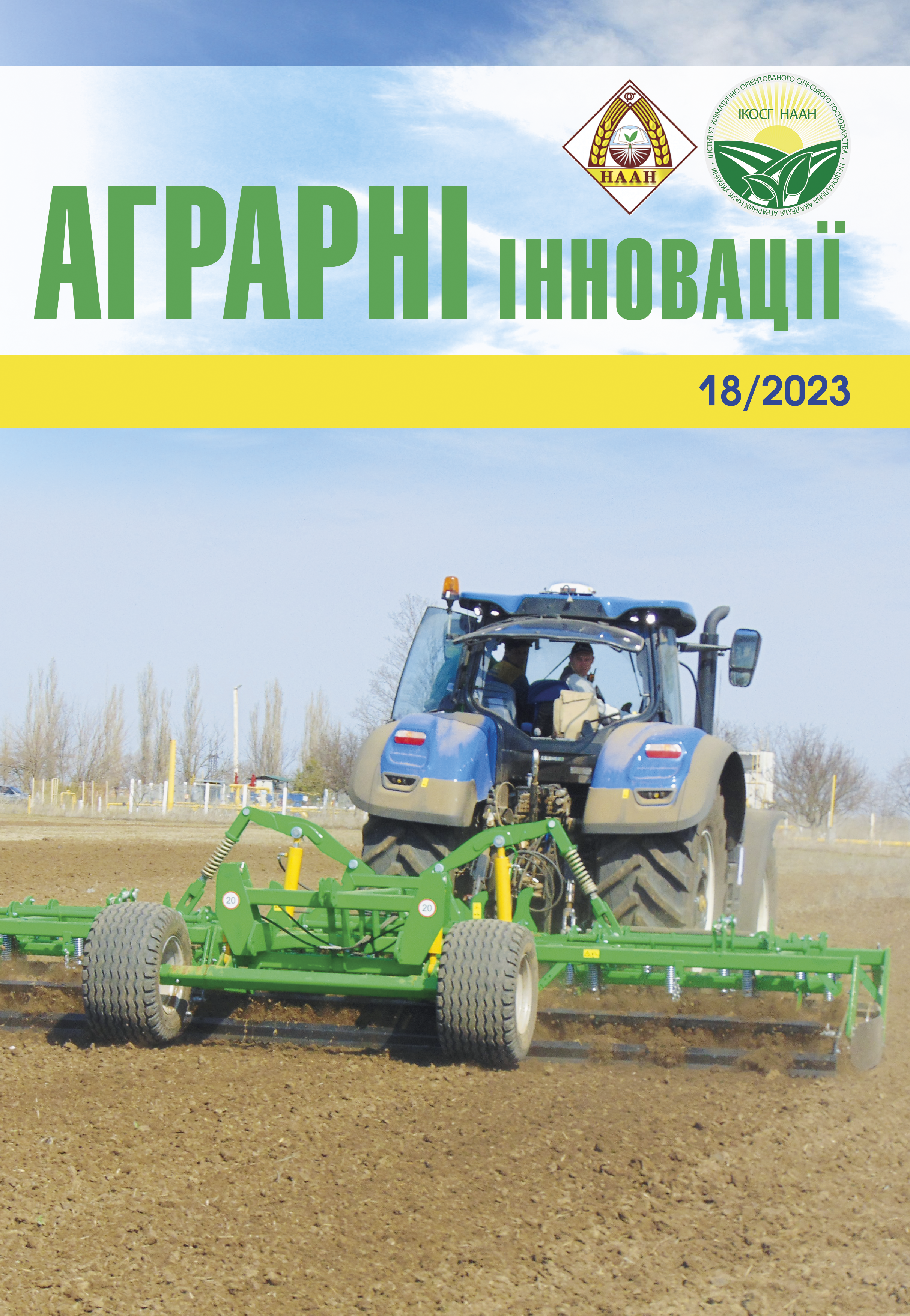INFLUENCE OF CLIMATIC FACTORS AND SEED STORAGE PERIODS ON THE QUALITY OF LINSEED OIL
Abstract
Purpose. The purpose of the research was to determine changes in the quality of oil flax seeds of different varieties on weather condition during cultivation and storage period. Methods. Laboratory and statical research methods used. The laboratory was used to determine the oil content of flax seeds and to establish the quality indicators of the oil obtained from flax seeds at different storage periods. Statistical for estimating the standard deviation in determining the oil content of seeds. Results. The article analyzes the weather conditions during the growing season of oilseed flax. It was determined that the amount of precipitation and air temperature during the research periods significantly deviated from the average longterm indicators, and the precipitation was characterized by unevenness of arrival. As a result of the conducted research, it was determined that the oil flax seeds grown in the agroclimatic conditions of Polissia of Ukraine have high quality and are suitable for use as food and technical raw materials. It was established that the Liryna variety had an oil content of 46.5–47.2 % on average over the years of experiments and was ahead of the Evryka variety by this indicator. Linseed oil had high quality indicators, its iodine value ranged from 178.4–184.2 gJ2/100g for the Eureka variety and 175.3–181.2 for the Liryna variety. A high iodine number determines a significant content of unsaturated fatty acids, which determines the oil as valuable when using it for food, pharmaceutical and technical purposes. The maximum oil content in seeds is set for the initial storage period – 38.8 and 44.5%, respectively, of the variety. At the end of the storage period, after 9 months, the oil content in the Evryka variety decreased by 4.1%, and in the Liryna variety by only 2.1%. A decrease in the iodine value was established depending on the storage period. This indicator of oil quality, depending on the shelf life, decreased from 182.1 to 179.6 (by 1.4%) for the Evryka variety and from 178.4 to 169.5 (by 5.0%) for the Liryna variety. At the end of the storage period, the acid numbers of linseed oils increased. Thus, at the end of the storage period, the content of free fatty acids in the oil obtained from the seeds of the Eureka variety increased by 1.7 times, for the Liryna variety, this indicator doubled. Conclusions. The climatic condition of Polissia ensure the production of high-quality oil, and the considered terms of storage of raw materials for its production, subject to the use of optimal regimes, ensure the quality regulated by state standard.
References
2. Посівні площі сільськогосподарських культур: Статистичний бюлетень. Київ: Вид-во державної служби статистики. 2021. 181 с. URL: https://ukrstat. gov.ua/druk/publicat/kat_u/2021/zb/05/zb_rosl_2020. pdf
3. Дрозд І. Ф. Вплив метеорологічних умов Передкарпаття на морфологічні та біохімічні показники льону олійного. Науково-технічний бюлетень інституту олійних культура НААУ. 2020. №29: С.112–122.
4. Дрозд І. Ф., Шпек М. Р., Лях В. О. Олійність сортів льоеу в різних умовах вирощування. Науково- технічний бюлетень інституту олійних культура НААУ. 2010. №15. С.45–48.
5. Овсяннікова Л. К., Валевська Л. О., Грищук Ю. В. Евдокімова Г. В. Вплив умов зберігання на зміну показників якостінових сортів льону. Прогресивні техніка та технології харчових виробництв ресторанного господарства і торгівлі. 2018. №1(27). С. 255–268.
6. Дідора В. Г., Деребон І. Ю. Технологічні показники якості льону олійного залежно від елементів технології вирощування в умовах Полісся України. Сільське господарство та лісівництво. 2017. №6. С.71–79.
7. Ковальов В. Б., Деребон І. Ю., Бучко К. Д., Федорчук С. В. Вплив тривалості зберігання лляної олії на якісний склад. Збірник наукових праць Уманського НУС. 2020. Вип. 96. С548–558.
8. Vozniuk N., Skyba V., Likho O., Sobko Z., Klymenko, T. Forecasting the adaptability of heat-loving crops to climate change in Ukraine. Scientific Horizons. 2020. 26(2), 87–102. DOI: https://doi.org/10.48077/ scihor.26(2).2023.87-102 .
9. Balabukh V., Tarariko O., Ilienko T., Velychko V. Influence of changes in air temperature on crop productivity formation in Ukraine at the turn of XX–XXI centuries (1981-2010). Agricultural Science and Practice. 2021. 8(3). 71–87. DOI: https://doi.org/10.15407/ agrisp8.03.071.
10. Kovalev V., Derebon I., Klymenko T., Fedorchuk S., Trembitska O., Lisovy M. (2020). Production of textile crops in conditions of radioactive contamination. Agroecological journal, 3, 73–79.
11. Насіння льону олійного для переробляння: ДСТУ 4967 (ДСТУ 4967:2008). – [Чинний від 2010–07–01]. Київ : Дерспоживстандарт України, 2010. 8 с.
12. Городній М. М. Прикладна біохімія та управління якістю продукції рослинництва / М. М. Городній, С. Д. Мельничук, О.М. Гончар, В.П. Каленський, Л.А. Ященко та ін. Київ: Арістей, 2006. 486 с.
13. Технологія зберігання і переробки продукції рослинництва: навч. посіб. / Г.І. Подпрятов, Л. Ф. Скалецька, А. М. Сеньков. Київ: Вища освіта, 2004. 271 с.
14. Скалецька Л. Ф., Подпрятов Г. І., Завадська О. В. Методи наукових досліджень зі зберігання та переробки продукції рослинництва. Київ: ЦП «КОМПРИНТ», 2014. 416 с.






